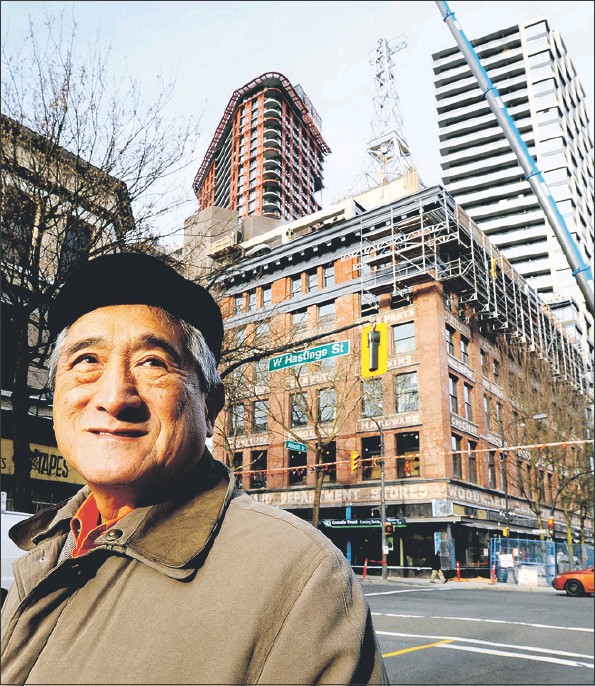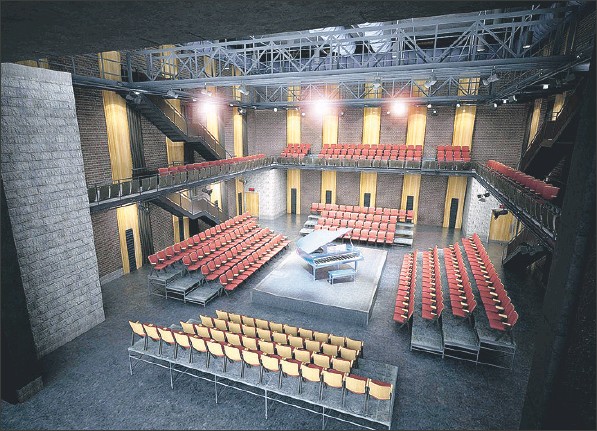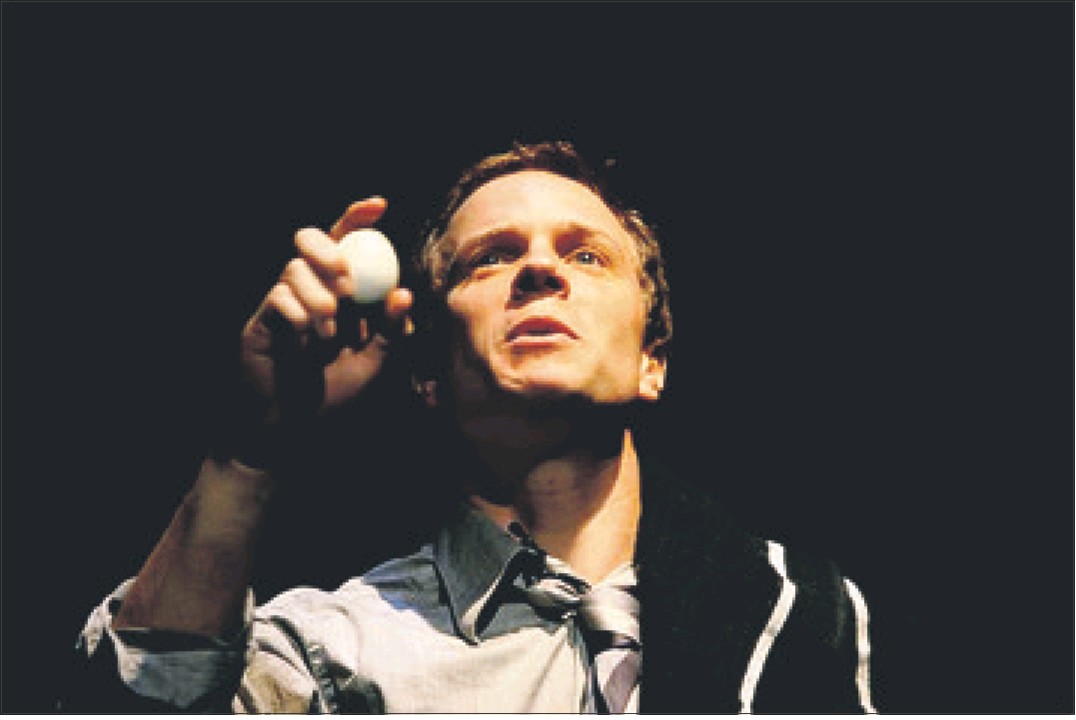New downtown Simon Fraser University campus will be a landmark arts complex for the city
Peter Birnie
Sun

Former SFU chancellor Milton Wong and his wife Fei Wong donated $3 million to the school and are lending their names to an innovative performance space at the heart of the arts complex. Wong also spearheaded the school’s fundraising campaign for the new downtown campus. Arlen Redekop/PNG

An artist’s rendering of the ‘extraordinary’ Fei and Milton Wong Experimental Theatre at SFU’s new downtown campus.

Jay Dodge of Boca del Lupo, an SFU grad, sees great potential for innovative work in the new theatre.
At the heart of the School for the Contemporary Arts, Simon Fraser University’s bold new downtown campus in the Woodward’s complex, sits the boldest thing of all — the Fei and Milton Wong Experimental Theatre. Milton Wong notes that some people felt the name was too long.
“They said we should just call it the Fei and Milton Wong Theatre, but I beg to differ,” Wong says. “I truly think that, from this point on, we have to be open to experiments for the fusion of all the different disciplines, from dance to film to technology, because that’s what’s going to make the centre work, and give Vancouver a cultural precinct that will become a cornerstone for keeping us pre-eminent in terms of creativity.”
The former SFU chancellor credits current university president Michael Stevenson for shepherding the school’s move into Canada’s most troubled neighbourhood.
“It takes vision,” Wong says, “to go into one of the most deplorable areas and go, ‘Hey, we should send our institution down there because it’s the best way of revitalizing the Downtown Eastside.’”
Wong and his wife donated $3 million to the school and were honoured with having their name appear on a truly revolutionary multidisciplinary venue. State-of-the-art doesn’t begin to describe how this three-storey black-box theatre has been configured to make it infinitely adaptable and then equipped with the latest in technological bells and whistles.
Wong is the eighth of nine children. His father came to Canada in 1908 and lived in Chinatown; Wong and his wife raised three daughters in a world far removed from the racism of old.
“When I travel across the country, I see that the city of Vancouver is very special. I think this fusion of all the different cultures is quite remarkable — very few elbows are out.”
Among his many accomplishments — fundraiser for Science World, catalyst for the Dragon Boat Festival, founder of the cultural-diversity nonprofit Laurier Institution — Wong is especially proud of having helped Hank Bull create Centre A.
“We needed something to begin the recognition of Asian culture impacting on our city,” Wong explains, “and it’s fascinating that Hank had the foresight to champion that.”
With what he describes as “a very big soft spot” for SFU, Wong agreed to head a fundraising campaign for the School for the Contemporary Arts. Yet even this successful business leader is finding the current economic climate a tough go as the campaign is about halfway to its goal of $30 million — “It’s really been tough, but we’ll just have to keep on plugging.”
Wong was at an art biennale in Shanghai a few years ago, and was amazed at the way the world’s creative communities are being linked.
“ Interactions of new media are causing us to change how we look at things,” he notes. “Look at your newspaper, the use of blogs and all that; it all has a material impact on how the arts are moving.”
While a full transfer to the new downtown home won’t take place until the summer, Wong is delighted that the debut of the Fei and Milton Wong Experimental Theatre comes early next month with Robert Lepage’s The Blue Dragon, which has been heavily influenced by modern Asian art.
“The mix of the theatre, professional groups like that coming in as well as being open to the community, is going to be a very good interplay,” says Wong, “to infuse what I hope to be a magical condition where the arts in Vancouver can find new boundaries. It has a lot to do with the economic well-being of the city. I know people see arts as off the table, but it’s core.”
Something wonderful blooms on Hastings
Coordinated chaos is the order of the day at the new downtown campus of Simon Fraser University’s School for the Contemporary Arts. In a scramble to meet looming deadlines for completion of key components of the new building at the north end of the Woodward’s complex, construction workers have very few working days left to finish a mountain of tasks.
That’s appropriate, given the school’s move off its own mountain in Burnaby. While the Downtown Eastside won’t see 1,800 students descend on the neighbourhood until September, many of the facilities must be ready for such looming events as Jerome Bel’s The Show Must Go On (part of the PuSh International Performing Arts Festival) and Robert Lepage’s The Blue Dragon/ Le Dragon Bleu (part of the Vancouver 2010 Cultural Olympiad).
A recent hard-hat tour certainly proven the necessity of hard-hats, with no shortage of hazards on offer, but there’s also plenty of evidence that something wonderful is about to bloom on Hastings Street. Not only will students in dance, theatre, music, film and other disciplines be taking a huge leap forward from the huddle of huts they populated up on the hill at SFU, but many facets of their new downtown digs will be made available, when possible, to serve communities beyond the school.
The jewel in the crown of the complex is a three-storey space so cool that it left at least one former student drooling at the prospect of returning to use it. Jay Dodge is an SFU alumnus whose theatre company, Boca del Lupo, is famous for hanging around — Dodge led the way into Stanley Park for much-lauded site-specific shows, including The Last Stand, Lagoon of Lost Tales and Vasily the Luckless, where cast members were often found dangling from trees, and he sees great potential for equally innovative work inside the Fei and Milton Wong Experimental Theatre.
“The Fei and Milton Wong is a pretty extraordinary theatre,” Dodge says. “I mean, for somebody with my inclination for rigging and vertical space, obviously that theatre is intriguing.”
The theatre’s deep well can accommodate any seating configuration for up to 450 people. Massive doors can seal off the stage area so it becomes a separate rehearsal hall, or another 125-seat performance space.
The floor is fully sprang and two overhead gantries allow endless configurations for the latest in lighting — as well as the chance for people like Dodge to do amazing things in the air above an audience. We’re likely to see the Wong first tested to its limits when Lepage moves in with his trademark orgy of effects.
There’s more. A pair of side-by-side 125-seat studio theatres, one configured for dance and the other for theatre, each features its own identical twin directly below. School for the Contemporary Arts director Martin Gotfrit explains why.
“Students need a long time to put a show in,” Gotfrit says, “and it seemed to make sense to have the rehearsal studios be exact duplicates of the performance spaces, so they can build and block and do all those things in a space that’s exactly like the one they’ll eventually perform in.”
“That really intrigued me as a creator of new work,” says Dodge. “It’s so great, the idea that you can essentially create in the same space as you perform — I thought that was a pretty smart design, and I’ve never seen it before.”
That clever copying is also true for another space, one which will house the school’s Indonesian gamelan orchestra and act as a focal point for world music.
A 350-seat lecture hall for film students is equally innovative, equipped to easily screen feature films, and Vancouver’s film and television community will be clamouring for the chance to book use of a professional-calibre sound stage with complete acoustic isolation.
The Audain Gallery on the main floor will present exhibitions in the visual arts.
A variety of studio spaces have been individually designed to match different disciplines, whether in the visual arts or dance or theatre or music, and hanging from the ceiling of every hallway are wire-mesh trays carrying all the wiring — no more pulling up the floors or gouging at the walls to replace outmoded technologies.
When Gotfrit is joined by Michael Boucher, SFU’s director of cultural development and programming, they’re asked if they received everything on their wish list for the move downtown. Both burst into laughter.
“We got caught up in that sweet moment when everybody was building everything,” Gotfrit explains, “and the cost of concrete was going up some huge amount every week. We were forced to reduce the size of the school, so some of the classes will be at Harbourfront Centre. Since it’s such a short walk, it hardly matters.”
Another crunch came when city planners demanded that the building’s northeast corner be cut off, reducing space even further.
Boucher and Gotfrit, though, relish the intimacy and attendant vibrancy to come, agreeing that what they’ve wound up with sure beats what will be happily left behind in Burnaby — and former student Dodge agrees.
“We essentially spent most of our time in portables,” he recalls.
“The black-box theatre up there was a portable, and we had raccoons coming out from underneath it.”
“Yes,” Gotfrit says with a chuckle, “we have all manners of creatures living in our space, which are ‘temporary’ structures built 30 years ago. Coyotes, raccoons, mice, mould — you name it, we’ve got it. We even have carpenter ants!”
Downtown, however, is clean as a whistle — or will be when they sweep up. Boucher has been hosting a steady stream of visitors keen to see the facilities; many groups have already expressed interest in partnering with the school.
“We’re early in the game on this,” he says, “but we definitely have been talking to various organizations about artistic outreach and crossovers. We’re going to reach out to the community in ways that make sense.”
And not just the community of artists such as Dodge and Boca del Lupo. Everyone at the School for the Contemporary Arts is keenly aware of their obligation to be good neighbours in the Downtown Eastside.
“We want to encourage and facilitate exchanges,” Boucher explains, “ where, for instance, significant artists visiting us might be invited to speak at the Carnegie Centre.”
Even supposed rivals, such as the fine-arts programs at the University of British Columbia, are on the guest list.
“The thing about Vancouver is that we all have to work together,” Boucher says.
—
SFU AT WOODWARD’S BY THE NUMBERS
– The school is designed to welcome more than 5,000 arts enthusiasts to music, film, theatre, dance and visual arts events throughout a year.
The facility of 125,000 square feet (more than 11,000 square metres) will include:
– The Fei and Milton Wong Experimental Theatre, which can accommodate staging configurations ranging from proscenium to arena and which can house audiences up to a maximum of 350 depending upon the size of performance area and the seating arrangement chosen. This space can be subdivided to create a separate 125-seat performance space. The full area of the floor will be sprang for dance or physical theatre.
– Two studio theatres capable of seating an audience of 125, one of which is optimized for dance, the other for theatre performance, but both of which could serve well for either form or for a variety of alternate performance forms.
– The World Art Performance Studio will house the School’s Indonesian gamelan orchestra and have a decor to match -somewhat warmer and less neutral than the studio theatres. This space will be the home of several public performance series such as music, world music, world dance and shadow puppet theatre.
– A 350-seat cinema/lecture hall equipped to screen feature films and house lectures, panel discussions and large classes at SFU Vancouver.
– A teaching gallery on the ground floor to accommodate contemporary visual arts exhibitions, either in the street windows or in all or part of the room. There are six moving wall panels that can be arranged as display walls or which can be used to partition the gallery into three parts.
The facility will house the majority of the teaching and administrative functions of the School for the Contemporary Arts. Other teaching and research facilities include:
– A film sound stage with acoustic isolation for the shooting of interior sequences, a film classroom and two 25-seat screening rooms.
– Three additional dance studios, each slightly different in character and optimized for different dance forms.
– Two additional theatre studios with sprang floors for movement training.
– A principal music teaching studio to complement the World Art Studio as well as smaller studios and practise rooms for teaching and studio work in acoustic and electronic music.
– Two visual art and interdisciplinary studios.
– A two-level multidisciplinary complex incorporating two computer teaching labs and numerous smaller computer-based editing and composing suites for film, video, graphics and design, and electro-acoustic music as well as several traditional film editing suites.
© Copyright (c) The Vancouver Sun

